Setup Configuration Options: Student Portal
Student Portal Configuration Overview
During project kickoff, clients are provided the Prosperity Portal Setup spreadsheet for completion. The responses from this survey are used to configure the Student Portal, including what features are available to students, and the look and feel of particular features. You will need to work with your Project Consultant to review and setup these configurations.
Getting Started with Student Portal Configuration
You will need to work with your Project Consultant to review and setup these configurations.
This guide shows you how to:
1. Set up global constants
2. Identify Student Menu options
3. Setup Welcome Page
4. Choose page templates and configurations for:
§ Student Profile
§ Current Courses
§ My Programs
§ Course Catalog
§ My Transcript
§ Document Library
Set Up Global Constants for Student Portal
You will need to work with your Project Consultant to review and setup these configurations. The responses recorded in the Prosperity Portal Setup spreadsheet are used by the project consultant to set up default values throughout the student portal. Examples of these include:
§ Are students allowed to create their own student account? Or is this done by an administrator, or an automatic import?
§ Can students view the Course Catalog before they are logged into the system? A typical ecommerce driven student portal will often have the Course Catalog available to the public, and a typical corporate driven student portal will typically have a private Course Catalog – only available to students once they are logged in
Set Up Welcome Page
When users log in to the Student Portal, a welcome page can be defined with custom html. Clients provide their project consultant with a Word document, PowerPoint file, or an HTML file containing the content for the welcome page.
Set Up Catalog Splash Page
If you are using an ecommerce driven training catalog, you can optionally define a custom splash page. Clients provide their project consultant with a Word document, PowerPoint file, or an HTML file containing the content for the splash page.
Define Menu Options
The student menu defines what pages within Prosperity a student has access to. You will need to work with your Project Consultant to review and setup these configurations.
Menu options include:
§ Student Profile
§ Training Map (Current Courses and/or My Programs)
§ Course Catalog
§ My Transcript
§ Document Library
§ Message Board
§ Custom Pages
Student Profile
Student profile information is displayed in both the Admin Portal and the Student Portal and is populated by three different methods, depending on your configuration. You will need to work with your Project Consultant to review and setup these configurations.
§ Bulk Registration: Importing the Registration History file.
§ Manual student enrolment and registration via the Admin Portal
§ Self registration by the student via the Student Portal
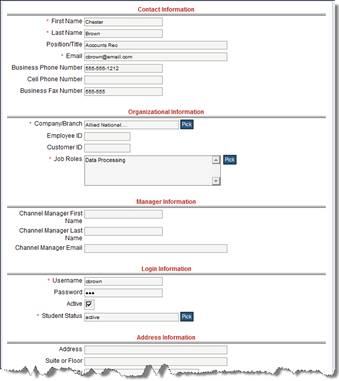
Figure 11: Student Profile in Admin Portal
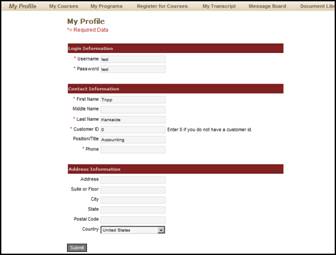
Figure 12: Student Profile in Student Portal
The data fields that display in the Student Profile form are configurable, in that you can identify the fields that should display. Configuring the Student Profile data fields involves specifying available fields you want to use.
Configuring the Student Profile data fields is accomplished by completing the Profile Checklist in which you check off the fields to display, and submitting it to your project consultant.
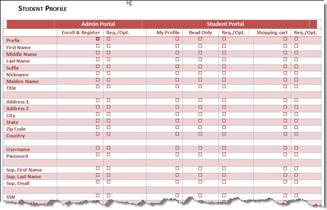
Figure 13: Student Profile Checklist
This form provides you with the field specifications for each data field, as shown below.

Figure 14: Student Profile Field Specifications
Training Map
The training map can be one or 2 pages, depending on how you will be using the site. There is a ‘course’ centric page (typically referred to as Current Courses), and a ‘program’ centric page (typically referred to as My Programs). Each of these page types have several different ‘looks’ that you can choose from.
§ Typically if the training you are offering is all elective training (students just pick what they want) you will probably only want a ‘course’ centric training map.
§ If all of your training is mandatory and/or has multiple modules that must be completed, then you probably will want a ‘program’ centric training map.
§ If you have a combination of mandatory courses and elective courses, you may want to consider having both views available to student: a course centric view.
The following pictures give you an idea of the different types of Training Maps you can use.
The training map is the page where a student can see their relevant courses. These are typically courses that they have registered for, but can also include courses they CAN register for.
Commercial (ecommerce driven) student portals will generally use a training map that shows courses that the student has purchased (or has otherwise been signed up for).
Here is the basic Training Map. It gives you a list of course that the student is registered for.

This is list of courses by Program:
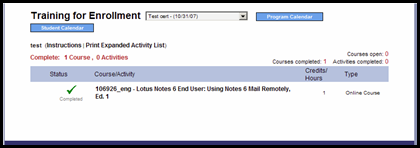
This is another example of a Training Map, with a list of programs and the courses.

This Training Map shows the courses that the student is registered for and shows courses that the student is eligible to register for. It also has a certificate link for courses completed, as well as an icon that explains the type of course(classroom, online, etc), as well as location and time.
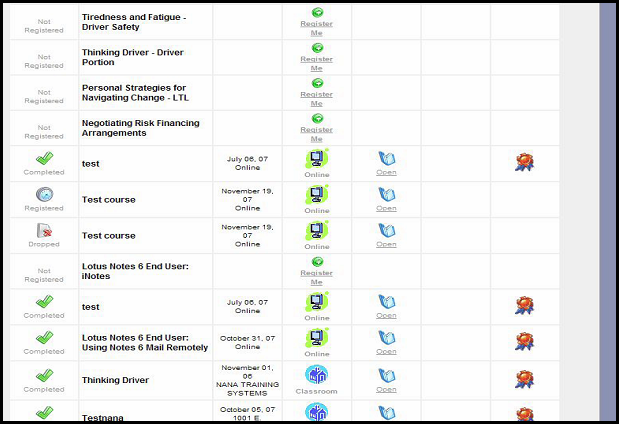
This training map shows all courses and activities within a given program, and allows the student to launch the course, exam, etc… directly from this screen without having to drill down. Details for the course can be displayed by clicking on the name of the course.
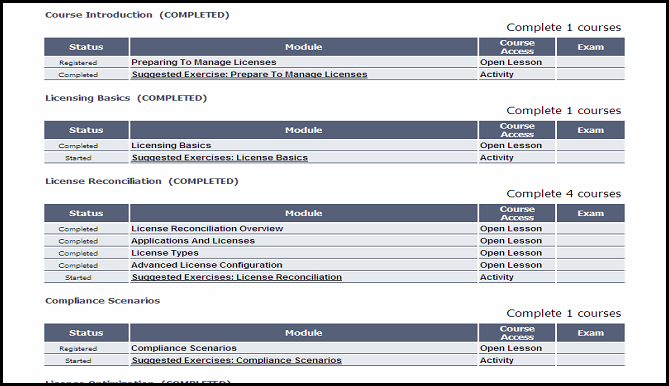
Student Transcripts
The following pages are samples of some Transcripts – The course history of a Student. Course Ids/Dates/Scores/etc.
This Transcript will show all the history of a student, group by program.
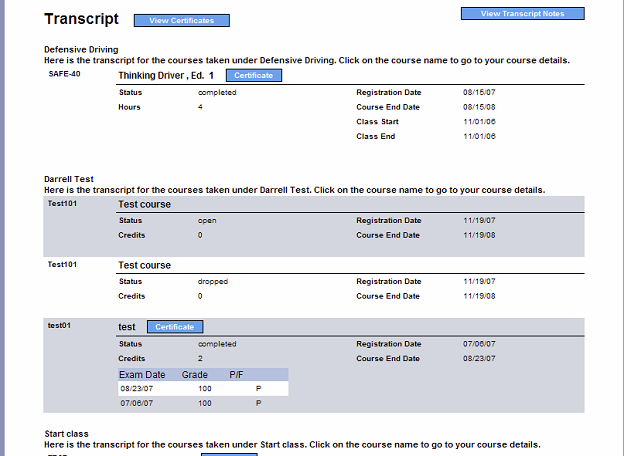
This is the most basic Transcript, which will show the status of the program and course, end date, registration date, and exam score.
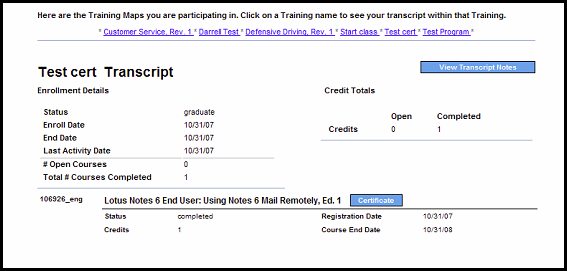
This Transcript can show inactive programs, and can be sorted by status, name, date, etc.
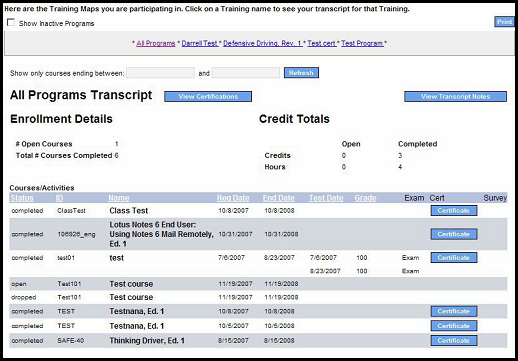
This Transcript shows the courses in a row of columns, and the program is selected from a dropdown list. You can also filter by date.
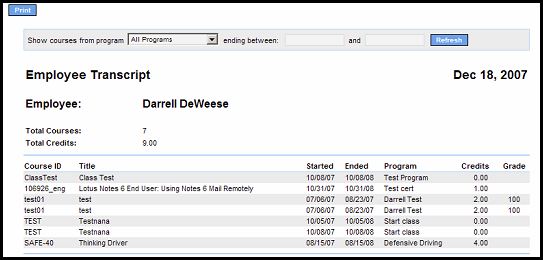
 Student Portal Configuration
Overview
Student Portal Configuration
Overview